| Christmas in Poland | |
|---|---|
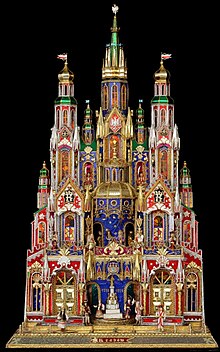 | |
 Christmas Eve Supper | |
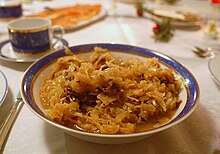 Traditional Christmas Day dinner serving of bigos on December 25 | |
 Christmas markets are held in every major city, especially in Kraków (pictured) | |
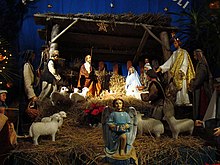 Nativity scene at the Catholic Church of Christ the King in Sanok | |
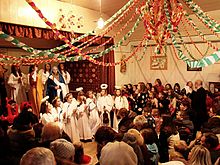 Nativity play (Jasełka or Herody) by children | |
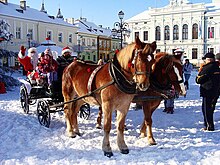 Kulig with Saint Nicholas |
Christmas in Poland is a major annual celebration, as in most countries of the Christian world. The observance of Christmas developed gradually over the centuries, beginning in ancient times; combining old Polish pagan customs with the religious ones introduced after the Christianization of Poland by the Catholic Church. Later influences include the mutual permeating of local traditions and various folk cultures. It is one of the most important religious holidays for Poles, who follow a somewhat strict traditional custom. Christmas trees are decorated and lit in family rooms on the day of Christmas Eve. Other trees are placed in most public areas and outside churches.[2] Christmas in Poland is called "Boże Narodzenie", which translates to 'God's Birth'.[3]
The Day of Saint Nicholas on 6 December is the unofficial beginning of the festive season in Poland.[4] Well-behaved children receive small gifts on the day, whereas naughty children receive a lump of coal or a twig, called "rózga". The highlight of the holiday is the most significant day, Christmas Eve on the 24 December. Polish Wigilia begins with the appearance of the first star, which corresponds to the Star of Bethlehem. During preparation, hay is spread beneath the tablecloth as a reminder that Jesus Christ was born in a manger.[5] According to tradition, an empty place setting is symbolically left at the table for the Lord or, for a lost wanderer who may be in need of food or shelter.[5] The supper begins with the breaking of the Christmas wafer known as "opłatek", a custom observed exclusively in Poland and two other countries. The meals must be vegetarian (with the exception of fish) as a sign of fasting and twelve different dishes are made, thus symbolizing the Twelve Apostles. The celebration ends with the exchange of gifts and a midnight mass in churches.
Other aspects of Polish Christmas include nativity plays called "Jasełka" or "Herody", outdoor nativity scenes, the singing of carols, most notably "God Is Born", and Kulig, a horse-pulled sleigh ride. The tradition of crafting and hand-making Christmas szopkas in Kraków was declared UNESCO Intangible Cultural Heritage.[1]
- ^ a b "UNESCO - Nativity scene (szopka) tradition in Krakow". ich.unesco.org. Retrieved 30 November 2018.
- ^ Cite error: The named reference
pmkamsterdamwas invoked but never defined (see the help page). - ^ "Christmas - Tłumacz - Onet.pl Portal wiedzy". Archived from the original on 2016-03-04. Retrieved 2013-09-12.
- ^ "How Poles Celebrate Christmas (Recipes Included)". Archived from the original on 18 January 2020. Retrieved 15 December 2017.
- ^ a b "Traditional Christmas Eve in Poland- Wigilia w Polsce- tradycje". 7 December 2015. Retrieved 15 December 2017.